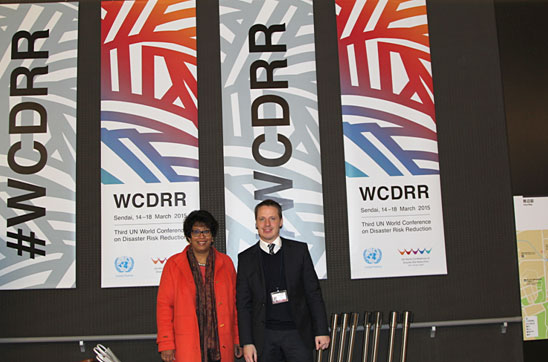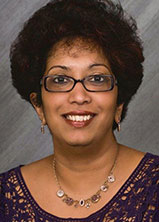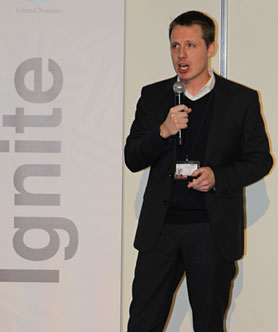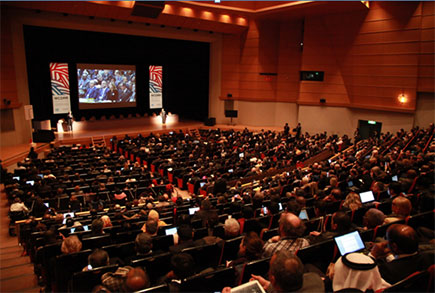Uni profs at UN Disaster Risk Reduction world conference in Japan
 Professor Dilanthi Amaratunga and Professor Richard Haigh at the Conference
Professor Dilanthi Amaratunga and Professor Richard Haigh at the Conference
Wed, 01 Apr 2015 11:29:00 BST
“...the Sendai Framework identifies the importance of science and technology... the need to link education with research and action...”
 TWO University of Huddersfield professors were among the global experts who contributed to a United Nations conference that agreed on a new framework aimed at decreasing death and destruction from earthquakes, extreme weather and other hazards around the world.
TWO University of Huddersfield professors were among the global experts who contributed to a United Nations conference that agreed on a new framework aimed at decreasing death and destruction from earthquakes, extreme weather and other hazards around the world.
The Third UN World Conference on Disaster Risk Reduction took place in Sendai, Japan. A total of 187 states were officially represented and more than 25 heads of state were present. There were more than 6,500 delegates and a public forum attracted over 40,000 people.
 Professor Dilanthi Amaratunga (pictured left) and Professor Richard Haigh (pictured right) of the University of Huddersfield’s Global Disaster Resilience Centre attended the conference and they believe that the Sendai Framework that emerged from the event is a major step forward.
Professor Dilanthi Amaratunga (pictured left) and Professor Richard Haigh (pictured right) of the University of Huddersfield’s Global Disaster Resilience Centre attended the conference and they believe that the Sendai Framework that emerged from the event is a major step forward.
It will be in place until 2030 and succeeds the Hyogo Framework for Action, drawn up by the UN in 2005, as a response to the devastation caused by the Indian Ocean tsunami.
“In the past ten years there has been lot of progress. The field has matured,” said Professor Amaratunga. “The Sendai Framework identifies the importance of science and technology in quite a lot of detail.”
Professor Amaratunga added that the 2005-2015 Hyogo Framework had been very successful in reducing human fatalities from disasters, especially in Asia. But now extra emphasis was being placed on disaster reduction rather than immediate response, and there was also a focus on the economic losses – often unsustainable – that can follow in the wake of a disaster.
Professor Haigh said that one of the big issues to emerge from the UN conference was the need to link education with research and action. This would mean an important role for universities.
“They are looking for an evidence-based approach for policy development. It is about targeting investment in the right areas.”
Key contributions
 The two Huddersfield professors participated in a number of events at the Sendai conference. Professor Amaratunga was a keynote speaker at the session named Frontiers of Disaster and Human Security. Her theme was “tackling societal challenges through international collaboration”.
The two Huddersfield professors participated in a number of events at the Sendai conference. Professor Amaratunga was a keynote speaker at the session named Frontiers of Disaster and Human Security. Her theme was “tackling societal challenges through international collaboration”.
One of Professor Haigh’s key contributions was to a forum on the role of higher education in advancing disaster risk knowledge and building local risk capacity. He spoke about the ANDROID Disaster Resilience Network, for which he is the Principal Investigator and which has 67 partners across 28 European countries.
One of the themes to emerge at Sendai was the need for closer regional and global links between higher education institutes, said Professor Haigh.
The professors and the Global Disaster Resilience Centre are frequent contributors to international initiatives and research. They are shortly to visit Vietnam for a meeting organised by the Asian Disaster Preparedness Centre.
The Sendai Framework for Disaster Risk Reduction
- The Sendai Framework calls for the United Nations General Assembly to integrate into its post-2015 strategy for sustainable development seven goals to reduce risk for loss of life, livelihood and critical infrastructure from disasters, through enhanced national planning and international co-operation.
- The Framework also calls for actions to protect populations and promote quick recovery, but also to prevent new risks, such as those caused by ill-planned urban growth in areas subject to flooding, landslides and effects of climate change.
- At the close of the Sendai conference, Margareta Wahlström, Head of the United Nations Office for Disaster Risk Reduction, said: “The adoption of this new Framework for disaster risk reduction opens a major new chapter in sustainable development as it outlines clear targets and priorities for action which will lead to a substantial reduction of disaster risk and losses in lives, livelihood and health.”







